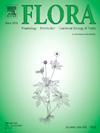大西洋季节性森林物候季节性及种间和种内变异对形态生化性状关系的贡献
IF 1.8
4区 生物学
Q3 ECOLOGY
引用次数: 0
摘要
季节和性状变异影响叶片物候的持续时间、强度、开始和结束。关注物种而不是种内变异可能会过度简化森林动态,并限制对形态-生化性状关联的预测。在两年多的时间里,我们量化了叶片的冲叶、落叶和7个形态生化性状,以探索与叶片物候相关的功能性状以及种间和种内变异的贡献。该研究涉及巴西大西洋森林的季节性常绿和半落叶森林中的10个落叶物种和21个常绿物种的423个个体。在季节性半落叶林中,落叶树种的冲叶和落叶季节性为0.74 ~ 1.02,而常绿树种的季节性为0.23 ~ 0.66。无论种间和种内变异性如何,该森林的冲叶和落叶季节性都是相关的。不同季节常绿林分叶习性间无明显差异。二者不相关,这可能表明抗旱性是该森林普遍存在的机制,导致叶片寿命更长,物候模式更连续。厚度、比叶面积和碳氮比与叶片物候有关,且在林间、种间和种内均存在差异。在半落叶林中,种内变异性对性状变异的影响更大,而在季节性常绿林中,种间变异性和叶片习性对性状变异的影响更大。我们的研究强调了量化叶片物候的季节性对个体的重要性,而不仅仅是对物种的重要性,对于增强对森林动态的理解,特别是在季节性非生物因素影响群落聚集的情况下。本文章由计算机程序翻译,如有差异,请以英文原文为准。
Phenological seasonality and contribution of inter- and intraspecific variation to relationships with morpho-biochemical traits in seasonal Atlantic forests
Seasonality and trait variability influence leaf phenology's duration, intensity, onset, and end. Focusing on species instead of intraspecific variability may oversimplify forest dynamics and limit predictions of morphological-biochemical trait associations. Over two years, leaf flush, fall, and seven morpho-biochemical traits were quantified to explore functional traits related to leaf phenology and the contribution of inter- and intraspecific variability. The study involved 423 individuals of ten deciduous and 21 evergreen species in a seasonal evergreen and a semideciduous forest in the Atlantic Forest, Brazil. In the seasonal semideciduous forest, deciduous species showed a seasonality of 0.74–1.02 in leaf flush and fall, compared to evergreens (0.23–0.66). Seasonality in leaf flush and fall was correlated in this forest, regardless of inter- and intraspecific variability. In contrast, leaf flush and fall did not differ between leaf habits in the seasonal evergreen forest. They were not correlated, which may indicate that drought resistance is a prevalent mechanism in this forest, resulting in longer leaf longevity and more continuous phenological patterns. Thickness, specific leaf area, and the carbon/nitrogen ratio were associated with leaf phenology and varied between forests and interspecific and intraspecific variations. Intraspecific variability contributed more to trait variance in the semideciduous forest, while interspecific variability and leaf habit were more influential in the seasonal evergreen forest. Our study highlights the importance of quantifying seasonality in leaf phenology for individuals, not only for species, for enhanced understanding of forest dynamics, particularly where seasonal abiotic factors impact community assembly.
求助全文
通过发布文献求助,成功后即可免费获取论文全文。
去求助
来源期刊

Flora
生物-植物科学
CiteScore
3.30
自引率
10.50%
发文量
130
审稿时长
54 days
期刊介绍:
FLORA publishes original contributions and review articles on plant structure (morphology and anatomy), plant distribution (incl. phylogeography) and plant functional ecology (ecophysiology, population ecology and population genetics, organismic interactions, community ecology, ecosystem ecology). Manuscripts (both original and review articles) on a single topic can be compiled in Special Issues, for which suggestions are welcome.
FLORA, the scientific botanical journal with the longest uninterrupted publication sequence (since 1818), considers manuscripts in the above areas which appeal a broad scientific and international readership. Manuscripts focused on floristics and vegetation science will only be considered if they exceed the pure descriptive approach and have relevance for interpreting plant morphology, distribution or ecology. Manuscripts whose content is restricted to purely systematic and nomenclature matters, to geobotanical aspects of only local interest, to pure applications in agri-, horti- or silviculture and pharmacology, and experimental studies dealing exclusively with investigations at the cellular and subcellular level will not be accepted. Manuscripts dealing with comparative and evolutionary aspects of morphology, anatomy and development are welcome.
 求助内容:
求助内容: 应助结果提醒方式:
应助结果提醒方式:


